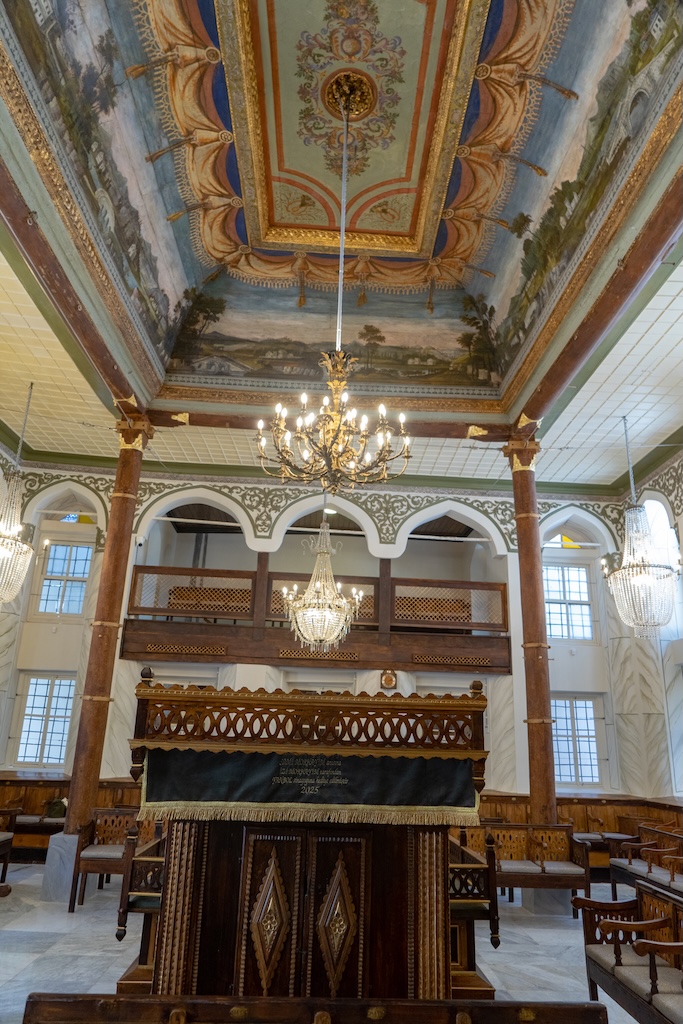It has a new exhibit of precious ritual material discovered in a hidden storeroom during the renovation process
JEWISH HERITAGE EUROPE, JULY 31, 2025
The historic Yanbol synagogue in Istanbul’s Balat neighborhood has reopened for worship after two years of restoration work. It features a new permanent exhibit called “Forgotten Rooms” that displays precious ritual objects and other material discovered in a hidden storeroom during the restoration process.
The synagogue reopened July 5 and the exhibition opened July 16, with a ceremony attended by members of the German consulate, which helped finance the work, the board of directors of the Quincentennial Foundation Museum of Turkish Jews, and others.
The Yanbol Synagogue is one of the four surviving ancient synagogues in Balat, a district once densely populated by Jews. It contains elements dating from Byzantine times in its courtyard, and its ceiling is decorated with oil paintings of nature.
According to the statement announcing the reopening, “It is understood from the statements of travelers and inscriptions that the main building was rebuilt in the 17th or 18th century following a fire disaster, and that it underwent major repairs in 1709, 1865, 1895 and latest in 2025.”
During this latest restoration process, it said:
a storage room was discovered on the upper floor of the synagogue, which had been closed and untouched for many decades. In this room, religious textiles, silver ritual objects, shivites and hundreds of religious books and documents were found. These artefacts were taken under protection, restored and turned into an exhibition in cooperation with the Quincentennial Foundation Museum of Turkish Jews. Two rooms of the synagogue were reorganised as exhibition spaces.

“A synagogue is not only a place of worship; it is also the guardian of the collective memory,” Nisya İşman Allovi, who curated the Forgotten Rooms exhibition, said at the opening.
These artefacts existed silently for generations. Today, they meet the public for the first time, opening a rare and poignant window into the depth, resilience and unique spirit of Jewish life in Balat.
Moris Levi, President of the Ahrida Synagogues Foundation, which takes care of the synagogues in Balat, said the reopening of the Yanbol Synagogue “made an important contribution to the common heritage of the community.”
The most recent restoration work began two years ago, “prompted by the urgent need to address structural and safety concerns—most critically, the roof, which was on the verge of collapse,” Nisya İşman Allovi told JHE.
“The electrical wiring was also severely damaged,” she said. “Once the work began, additional structural issues emerged, which extended the scope of the restoration. Over time, all areas of the synagogue were rehabilitated, including the annex buildings. Thanks to the work of decorator Anna Fresko, the synagogue has regained its authentic colors and grandeur in harmony with its historical significance.”
During the restoration, she said, a storage room was opened for the first time in years.
“Its contents—religious artifacts, documents, and ceremonial items—had remained untouched for decades, which made the discovery quite valuable from a cultural and historical perspective,” she said.

These are now displayed as the Forgotten Rooms exhibition, in two rooms in the synagogue complex.
One room houses a collection of Judaica artifacts including a variety of religious textiles, silver ritual objects such as Rimonim and Torah crowns and shields; Torah binders, Torah pointers, spice boxes, Hanukkah menorahs, and oil lamps; as well as scrolls and visual texts including Megilat Esther and Shiviti plaques.
The second room has no display cases, but allows visitors to view the original wall paintings that were preserved during the restoration.
According to the architect Hayim Beraha, who carried out the restoration, the synagogue complex consists of two distinct construction phases, the main building — prayer hall — and the surrounding rooms.
“The prayer hall features a mixed stone and wood structure,” he said in a statement to JHE.
The wooden components required structural retrofitting. During this process, all artworks, decorations, wall paintings, and—most importantly—the panoramic city view from the Yambol roof were carefully conserved and restored. Special care was taken to conserve and restore the synagogue’s original artwork, decorative elements, and wall paintings.
The rooms surrounding the prayer hall presented a different challenge, he said. “The structural elements reflect pre-Ottoman, possibly Byzantine, periods. Some surviving wall paintings were preserved and conserved.
The restoration project, including research and on-site work, has opened up a new dimension of discussion—particularly regarding the historical coexistence and transitions between Romaniot and Sephardic Jewish communities at the site.

